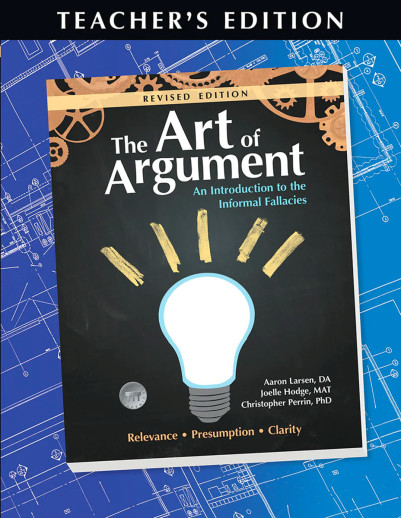We use cookies to make your experience better. To comply with the new e-Privacy directive, we need to ask for your consent to set the cookies. Learn more.
Art of Argument Revised Edition Teacher's Edition
This teacher’s edition of the revised course guides you through teaching 28 fallacies either to individuals or to a class. This edition includes discussion answers, a glossary, bibliography, endnotes (and a place for personal notes), chapter and unit tests, and answers. Answers are provided in-text and additional notes fall at the end of each chapter. Two appendixes provide creative options for applying fallacies: (A) a theatrical play demonstrating common fallacies (enter some cute high-school humor. What to expect with a title, “Bill and Ted’s Excellent Election”) and (B) Love is a Fallacy, a first-person creative writing by Max Shulman (©1951). Appendix C provides succinct yet thorough definitions of all fallacies, organized by type and a fallacy tree as a visual organizer. Appendix D provides a taxonomic “Table of You!”
A 23-page suggested course schedule is
available as a free download, which provides homework and composition
assignments, additional links, classroom assignments, an optional end-of-year
project, connections to other Classical Academic Press composition and
argumentation products, and more. Please note: this Revised Edition will not
correspond with the previous student edition. Digital product access comes with purchase of the Teacher
Edition and is available by setting up a My Library account at the publisher’s
website. 296 pgs, pb. ~ Ruth
Revised for the twentieth anniversary of its original release, the award-winning The Art of Argument is a robust, delightful, and creative text designed to introduce students as young as 7th grade to the foundations of logic and critical thinking. The Art of Argument will impart to students the skills they need to craft accurate statements and identify the flawed arguments found so frequently in commercials, articles, books, movies, songs, TV shows, everyday discussions, and other media. This revised edition features enhanced explanations, numerous examples of each fallacy, an updated design, and a taxonomic visual guide to the informal fallacies.
This teacher's edition provides the entire student text as well as robust resources, including additional explanations, supplemental resources and examples, pedagogical suggestions, alerts for common student pitfalls, answers to chapter exercises, and chapter and unit tests with their respective answer keys.
Laced with humor and practical applications, Classical Academic Press strives to make logic accessible. And succeeds, too! The series has more background material than other logic books plus lots of "modern" examples. Making great use of dialogues and cartoons, there are some practice exercises but the emphasis is more on the "meat" of the text rather than on doing exercises. This sets them apart from other logic courses and makes them the perfect choice for students who want or need background information more than practice. This series is user-friendly and requires very little prep on the teacher's part although teacher-student interaction is necessary to maximize the learning. Art of Argument would be the starting place for a Jr. High student followed by Argument Builder and/or Discovery of Deduction, which can stand alone or be used together.
Each Student Text is designed to be worked in with the student thinking through and writing out responses to the material being presented. Teacher Editions are predominantly full-text answer keys but often include teacher's notes (a list of suggestions and recommendations for teaching the course) as well as ideas for supplementing and enriching the study. ~ Janice
Socrates is the "go to" person when it comes to fallacies (occurrence of bad or incorrect reasoning) and his perspective on the three basic categories - fallacies of irrelevance (points that don't relate to the issue), of presumption (assumptions that are not justified or necessary), and of clarity (language that confuses and muddies) - is sought via time-travel. Several examples of each are provided plus the student has the opportunity to identify fallacies in cleverly fabricated magazine advertisements. Fallacies are printed on the inside covers of the Student Text for easy reference. Both Student and TE (each about 230 pgs, pb) have appendices that include a play and a short story that illustrate fallacies as well as a Glossary and Bibliography. TE includes reproducible chapter, unit, and final exams (with answer key). DVDs include 28 sessions (one for each fallacy) in which three teachers and 4 students present, define, discuss and explain the fallacy. As in the text, the DVDs emphasize a practical application to the student's life through advertisements, political speeches, and various moral/ethical debates.
| Product Format: | Paperback |
|---|---|
| Brand: | Classical Academic Press |
| Grades: | 7-12 |
| ISBN: | 9781600514517 |
| Length in Inches: | 11 |
| Width in Inches: | 8.5 |
| Height in Inches: | 1 |
| Weight in Pounds: | 2.5562 |

